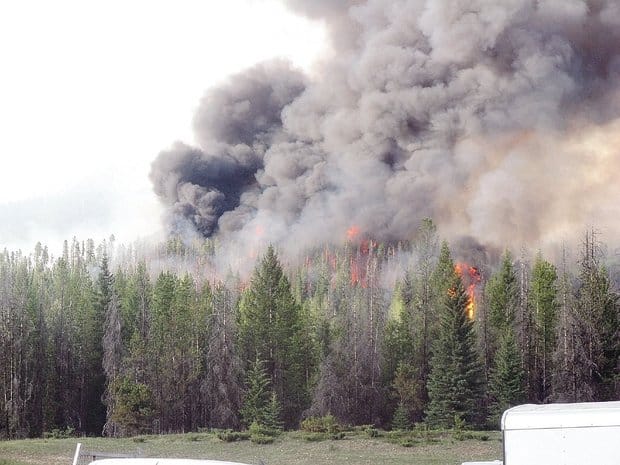
The black smoke signals a particularly hot area in a prescribed burn in British Columbia’s Kootenay National Park in 2008, when trees killed by mountain pine beetles were on the ground. Idaho’s Sawtooths have similar lodgepole pine forests.
PROVIDED BY PARKS CANADA — Provided by Parks Canada
Does anyone know any philanthropists? I propose an NCFP field trip to Kootenay National Park.
Here’s a link to a story by Rocky Barker in June.
A CANADIAN MODEL
The Forest Service burns thousands of acres of ponderosa pine in prescriptive burns, but very little lodgepole. But Stanley leaders have looked to Canada for a late-winter, early-spring model for burning lodgepole, and they hope the Forest Service will consider it.
Most of Southern Idaho forests have burned over the past 25 years. With those forests cleared of built-up fuels, firefighters have made steering new fires into those previously burned tracts their main tactic.
But the heart of the Sawtooth Valley remains largely untouched over the same period.
“What remains to burn is right in front of us,” said Herbert Mumford, mayor of Stanley, which has 63 year-round residents.
There is only one power line connecting the mountain hamlet to the grid that snakes up the Salmon River from Challis. If a fire burns through the line, Salmon River Electrical Cooperative officials tell Mumford, it could take weeks to rebuild it.
No electricity would mean the sewage treatment plant would stop working, Mumford said, leaving the community helpless. That’s why he and Steve Botti, president of the City Council, are leading the effort to seek a more aggressive prescriptive-burning effort.
“Should we just sit back and buy marshmallows and weenies and wait for the fire to start?” Mumford said.
Botti, a retired National Park Service fire ecologist at Boise’s National Interagency Fire Center, was familiar with Parks Canada’s ambitious burning program in lodgepole pine forests in British Columbia and Alberta. Two of the program’s leaders came to Stanley this spring to tell of their success.
A MATTER OF TIME
In Kootenay National Park, about two hours west of Calgary, Parks Canada embarked on a landscape-level program designed to burn strategic chunks of forest under carefully managed conditions. The burning is done during spring or late fall. Loggers cut large open spaces, or “anchors,” to ensure that the fire stays within its parameters and to protect revenue-producing forests nearby.
The logging is done in winter, to reduce impact on the land and the park’s visitor season.
“It is understood as a sacrifice on national park land” to prevent future fires and improve the larger ecology, said Rick Kubian, resource conservation manager for Lake Louise, Yoho and Kootenay parks.
The fires have been successful. They burn the identified areas in a mosaic pattern, which will slow down any future fire that tests the forest. It’s the kind of burning that Stanley leaders hope they can convince the Forest Service to try in Idaho.
Sawtooth National Ran-ger Joby Timm is pleased that Stanley has put together the fire collaborative and is encouraged by its support for increased management. He proudly points to the agency’s record of preventive “treatment” of 90 percent of the recreation area’s wildland-urban interface.
He and the Forest Service’s local fire managers support what the Canadians have done, but Timm is skeptical that large Canada-style winter burns, along with the necessary logging, could get the support needed from Idahoans who want their scenic views unchanged.
“Politically and socially,” Timm said, “I don’t know how logging a quarter-mile swath would be accepted in the Sawtooths.”
Forsgren, Mumford and Botti all say that it’s just a matter of time until the Sawtooth Valley burns. Those who want to see it left alone could see the view they love blackened and an entire summer recreation season lost.
The next step is for the collaborative group to make a formal proposal to the Forest Service.
“Fire is part of the ecosystem, but we don’t want it all to burn,” Forsgren said. “We’d like the Forest Service to do some logging and prescribed burning so when the fire comes, it drops to the ground, where they can fight it.”
Read more here: http://www.idahostatesman.com/2013/06/02/2599958/protecting-stanley-from-wildfires.html#storylink=cpy